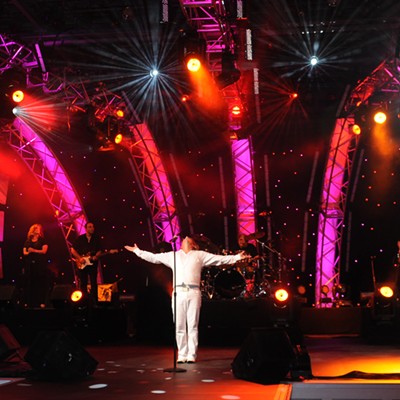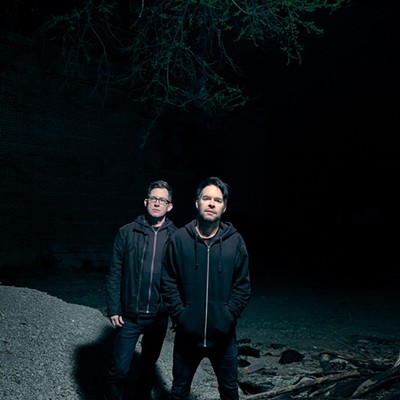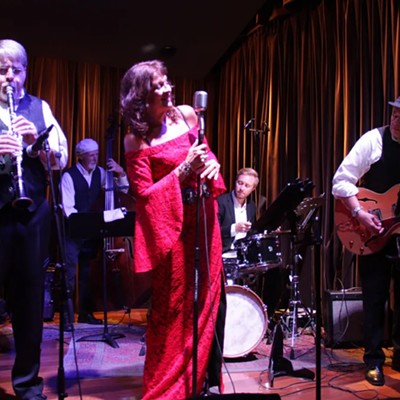The joyous collision of multiculti, electronic-tribal dance music, not to mention the images of a mob-like ritual release inspired by the New York City-based band's name, brings to mind a post-industrial, sci-fi celebration in the last safe haven for humanity.
During a recent interview, guitarist Josh Diamond was reluctant to liken his group's music to a religious experience, but he admitted that a spiritual element exists in Gang Gang Dance's work.
"I think that the word (religion) gets you into a semantic dead end because of all the baggage that gets attached to it. Spirituality is probably a more appropriate word. None of us are religious. I mean, I am Jewish, but I don't practice it," he said recently via telephone from the road.
One of the most striking and dynamic tracks on the new album is even titled "First Communion."
Diamond continued: "I think music in general, and I hope our music in particular, really helps us connect to other people in a really amazing way that often in the right circumstances allows us to feel part of something larger than ourselves; it's like a gateway to reaching our higher potential."
Gang Gang Dance will visit Tucson to play on Monday, Nov. 17, at Plush. The gig will mark the band's third appearance in Tucson, Diamond said.
GGD is touring to promote Saint Dymphna, the group's fourth full-length album, which was released in October. Since its 2001 formation, Gang Gang Dance also has peppered its release schedule with limited-edition vinyl and EPs, as well as last year's multimedia DVD/CD release Retina Riddim.
The group named its latest recording after the patron saint for those who suffer from mental illnesses and nervous-system disorders.
Saint Dymphna listeners will experience a synapse-rattling production that sounds like Brian Eno's spacious pop soundscapes sharing brainspace with Timbaland's claustrophobic, off-kilter creativity. This is infused with an array of seemingly disparate, though complementary, elements: new-wavey '80s pop meeting African polyrhythms; Southeast Asian bar bands jamming on some Indian hip-hop; Latin grooves blending into reggaeton, dub, trip-hop and techno; hypnotic guitar textures à la My Bloody Valentine twisting through a little glitchcore; and a lot of the good ol' punk-rock DIY spirit.
The result has been called avant-garde, experimental and/or art rock. It's safe to say, however, that Gang Gang Dance's singular style employs free-form arrangements and generally dispenses with standard verse/chorus/verse song structures.
Based on the ethnomusicological diversity of its music, one might wonder if Gang Gang Dance is always in the process of reinventing itself. Diamond begged to differ, based on the premise that he and his bandmates have never had a formula so intransient that it needed to be reinvented.
"We are interested in emotional music, most of all. I guess from all of those different, far-flung things that we just work with stuff that we have emotional connections with. We don't think it out ahead of time or on purpose.
"The commonality among all that music is that it sounds good to our ears. ... We try to be open to the world, and we try to have our ears be open, too."
Although GGD began officially seven years ago, the members have been playing together in various formations since late in the 20th century. Keyboardist and electronics wiz Brian DeGraw (who is also a visual artist), vocalist Liz Bougatsos, drummer Tim DeWitt and Diamond have done time, together and apart, in such outfits as The Cranium, Death and Dying, Russia and SSAB Songs.
According to Diamond, GGD's music initially was pretty out there. "Early on, we were really a straight improvisational band, almost to the point where we wouldn't rehearse at all, and (would) get up there and just play. It was kind of much more all over the place. I think we've become a lot more focused since then."
In its early years, Gang Gang Dance also featured singer Nathan Maddox, who died in an unfortunate accident in August 2002. He was struck by lighting while watching a thunderstorm from a rooftop, Diamond said.
"But he's still part of us. (His influence) is in there in some of everything we do, even after so many years. We are, like, channeling him all the time."
Despite the fact that Saint Dymphna is still fresh in stores, the members of Gang Gang Dance already are planning their next album.
"In January, we are going to record in Joshua Tree, Calif., out in the desert. A friend of ours has a little cabin in the middle of nowhere. We're going to spend a month there and make the next record."
Considering the dizzying cultural influences of its home base, GGD is ready for some isolation: "There's something inviting about the idea of just relying on ourselves out there without the distractions of New York," Diamond said.
Currently touring with Gang Gang Dance (and slated to open at Plush) is Rainbow Arabia, a Los Angeles-area band that practices a frenzied version of Middle Eastern and North African music as filtered through Western rock and dance-music sensibilities.
Behind the vocals of Tiffany Preston, Rainbow Arabia has drawn comparisons to M.I.A. and Santogold, but the abrasive pan-globalism of Second Edition-era Public Image Ltd. also is a touchstone. The group saw the release of its debut EP, The Basta, in September.







